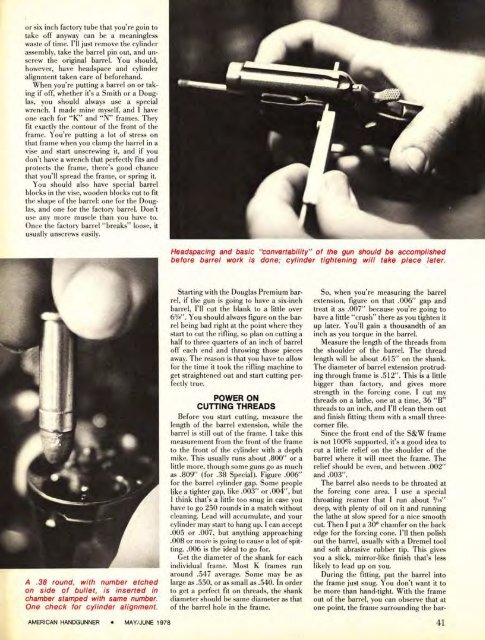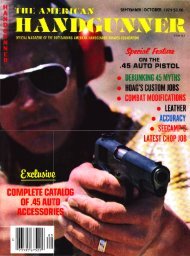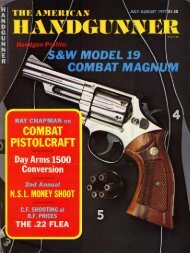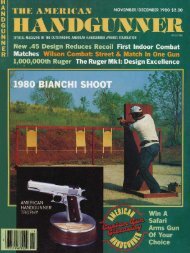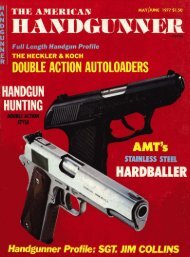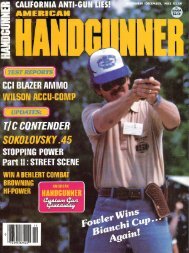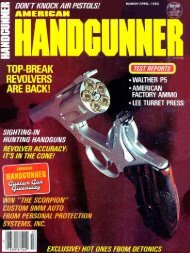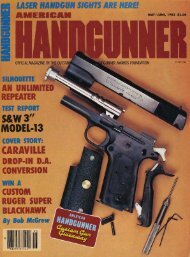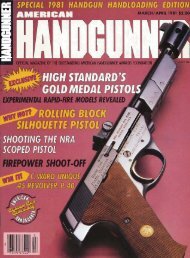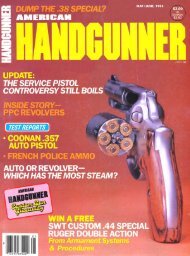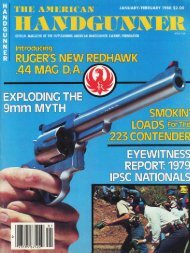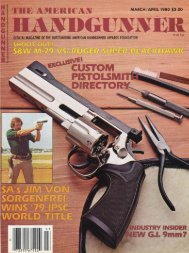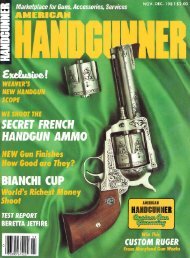Two strategically placed empty cartridge cases can sharply reduce stresson cylinder components during disassembly, as Power explains in text.tice a tendency to foul the bore quickly,especially with heavy loads.One-inch diameter is about right. Someof the 'smiths are using 'Is" or 15/~e" barrels,and one is using an inch and a sixteenth,but the top shooters tell me theone-inch diameter is just about right forhandling characteristics in a six-inch barrelon a Combat Magnum or other "K"frame Smith & Wesson.A tot of PPC shooters like a one-in-tenhch twist in their wadcutter guns, but beyondfifty yards, they're losing something.I think one-in-fourteen is just as good for awadcutter within fifty yards; it's better beyondfifty, and it gives more optimum stabilizationof 158-grain ball .38 ammo, andof hotter loads.The Combat Magnum comes withS&Ws standard .38/.357 twist of one turnin IS3/4", and there's really nothing wrongwith that. One-in-fourteen is about as lowas you can go with a round-nose bullet; aone-in-ten would L'overstabilize" the projectile.A person using faster bulletsshould have a slower twist.In terms of pure accuracy potential, Idon't see that much difference betweenone-in-ten, or -twelve, or -fourteen, or-eighteen, when you're shooting wadcutterammo. The advantage of the Douglas Premiumbarrel is the quality and consistency,and the added weight, more thanthe choice of twists.To give you a frame of reference, agood S&W barrel will hold wadcutter bulletsin 21/zr' at fifty yards from a machinerest. I've seen some that would group infive to eight inches. With a Douglas Premiumbarrel, I wouldn't let it out of myshop if it didn't stay in one and threeeighthsinches. Of course, this assumesthat the rest of the gun is properly in tune.POWER ON COMBAT MAGNUMACCURACY WITH 38 LOADSThe ideal gun to build a full-house con--version on is the Model 13, the .357 Militaryand Police; my next choice would beeither the Model 10 .38 or the CombatMagnum. The fixed-sight frames for theheavy barrel " K frame guns allow you toput a BoMar rib on with more pleasinglines, and I like the thicker, more rigidtopstrap, though it's not really necessary.The good thing about the Combat Magnumcylinder is that, being counterbored,it's easier to bevel and adapt for quick re-loading. Of course. the fact that it's cer-'2tified safe with Magnum loads makes youfeel a little more comfortable about shootingreloads in case somebody made a mistakeat the loading bench and gave you asuper-hot one.All things considered, the Combat Magnumis an ideal basis for a full-house PPCconversion: the onlv shortcoming is that "when you remove the rear sight to makeroom for the BoMar rib, you'll leave a littleopen notch showing. I hear a lot ofpeople talk about how the longer jumpthrough the chamber in a .357 cylinderwill hurt accuracy with .38 wadcutterammo, but in all my benchrest testingwith all makes and models of guns, I'venever noticed a difference. That's an interestingconcept, but I don't think it carriesover into reality. A lot of championshipshave been won with worked-overModel 19s.POWER ON MODIFYINGTHE HAMMER NOSEFor ultimate consistency in ignition,you want the firing pin to hit in exactly thesame place-on the primer every time,especially if you've gone to the trouble toget the cylinder lining up just so. The bestway to ensure this is to spring-load thehammer, the way the factory does now onthe Model 66.On a regular 19, you can remove thehammer nose, cut a groove in back of it,and install a very small, weak spring inthere, cut to the same dimensions as theS&W factory does on "N" frame hammernoses. Use the smallest spring you canfind that will fit.I put a spring-loaded hammer nose inall of my custom guns. The regular designallows the firing pin to sometimes ding theframe at 12 o'clock. You can grind out thetop of the frame at that point with thesmall attachment on a Dremel tool, or ,with a Carbaloy cutter. The trouble withgrinding it out is that it's awfully easy to gotoo far and wind up with an elongated firingpin hole. You want to grind out theframe where the hammer goes through;about ten-thousandths on the top and onboth sides of the hammer, so that no panof the hammer can possibley rub on theframe when it drops.POWER ONDISASSEMBLING THECOMBAT MAGNUM CYLINDEROn any Smith & Wesson, if you've got agood, tight, well-aligned cylinder, youshould leave it alone. You shouldn't takeit down any further than removing thecylinderlyoke . . assembly as a whole forcleaning.If you do disassemble the cylinder,make sure you're unscrewing the ejectorrod in the right direction. See if there's anuncheckered '1s'' band of metal betweenthe length of the rod and the part that'sknurled; if it's there, it was manufacturedsince around '58. and has a left-handthread; otherwise it's a right-hand threadand you have to unscrew it counter-clockwise.When you take apart a Smith & Wessoncylinder assembly, you'll notice thatthe extractor is supported in thecylinderby a groove down the middle of it, and twosmall retainer pins. A little secret a lot ofgunsmiths use is to put two empty shellcasings in the cylinder, by each of thosepins; that helps keep the extractor in line,and prevents stress being placed on thosetwo pins that could damage them if the cylinderwas empty.NOTE: This part has dealt with modificationsthat require a definite degree of gunsmithingskill. They are not for the uninitiated;the guy who's a shooter ratherthan a gunsmith will find them of technicalinterest, and can use them as a guidein instructing a pistolsmith as to the modificationshe desires.In the first part of this article Rontouched briefly on some points regardingthe selection of the heavy barrel. In thispart, the master gunmaker goes into thesubtle details of fitting the barrel to theframe.POWER ON SEQUENCEI prefer to complete the barrel installationbefore I go on to slicking up the action.So much of accurizing the revolverdepends on the cylinder's relation to thefinal barrel, that adjusting it for the foursteaAMERICAN HANDGUNNER 1 MAY/JUNE <strong>1978</strong> *Â¥"
or six inch factory tube that you're goin totake off anyway can be a meaninglesswaste of time. I'll just remove the cylinderassembly, take the barrel, pin out, and unscrewthe original barrel. You should,however, have headspace and cylinderalignment taken care of beforehand.When you're putting a barrel on or takingif off, whether it's a Smith or a Douglas,you should always use a specialwrench. I made mine myself, and I haveone each for "K" and "N" frames. Theyfit exactly the contour of the front of theframe. You're putting a lot of stress onthat frame when you clamp the barrel in avise and start unscrewing it, and if youdon't have a wrench that perfectly fits andprotects the frame, there's good chancethat you'll spread the frame, or spring it.You should also have special barrelblocks in the vise, wooden blocks cut to fitthe shape of the barrel: one for the Douglas,and one for the factory barrel. Don'tuse any more muscle than you have to.Once the factory barrel "breaks" loose, itusually unscrews easily.Headspacing and basic "Convertability" of the gun should be accomplishedbefore barrel work is done; cylinder tightening will take place later.A .38 round, with number etched. on side of bullet, is inserted inchamber stamped with same number.One check for cylinder alignment.Starting with the Douglas Premium barrel,if the gun is going to have a six-inchbarrel, I'll cut the blank to a little over6". You should always figure on the barrelbeing bad right at the point where theystart to cut the rifling, so plan on cutting ahalf to three quarters of an inch of barreloff each end and throwing those piecesaway.The reason is that you have to allowfor the time it took the rifling machine toget straightened out and startcutting per-. , . A 8fectly true* :;, :. , ': ..-$' * ,POWER ON A $' ,,ACUTTING THREADS *Before- you start cutting, measure thelength of the barrel extension, while thebarrel is still out of the frame. I take thismeasurement from the front of the frameto the front of the cylinder with a depthmike. This usually runs about .800" or alittle more, though some guns go as muchas .809" (for .38 Special). Figure .006"for the barrel cylinder gap. Some peoplelike a tighter gap, like .003" or .004", but1 think that's a little too snug in case youhave to go 250 rounds in a match withoutcleaning. Lead will accumulate, and yourcylinder may start to hang up. I can accept.005 or .007, but anything approaching.008 or more is going to cause a lot of spitting..006 is the ideal to go for.Get the diameter of the shank for eachindividual frame. Most K frames runaround .547 average. .Some may be aslarge as .550, or as small as -540. In orderto get a perfect fit on threads, the shankdiameter should be same diameter as thatof the barrel hole in the frame. 'So, when you're measuring the barrelextension, figure on that .006" gap andtreat it as .007" because you're going tohave a little "crush" there as you tighten itup later. You'll gain a thousandth of an. - '.inch as you torque in the barrel.-,Measure the length of the threads from'" :the shoulder of the barrel. The threadlength will be about .615" on the shank.The diameter of barrel extension protrud-ing through frame is .512j1. This is a little ".bigger than factory, and gives more '? 'strength in the forcing cone. I cut my I"threads on a lathe, one at a time, 36 "El" ,threads to an inch, and I'll clean them out ¥ .'and finish fitting them with a small three- ,-corner file.Since the front end of the S&W frameis not 100% supported, it's a good idea tocut a little relief on the shoulder of thebarrel where it will meet the frame. Therelief should be even, and between .002"and .003".The barrel also needs to be throated atthe forcing cone area. I use a specialthroating reamer that I run about '/id'deep, with plenty of oil on it and runningthe lathe at slow speed for a nice smoothcut Then I put a 30 chamfer on the backedge for the forcing cone. I'll then polishout the barrel, usually with a Dremel tooland soft abrasive rubber tip. This givesyou a slick, mirror-like finish that's lesslikely to lead up on you.During the fitting, put the barrel intothe frame just snug. You don't want it tobe more than hand-tight With the frameout of the barrel, you can observe that atone point, the frame surrounding the bar-ICAN HANDGUNNER * ~IAYIJUNE <strong>1978</strong>


